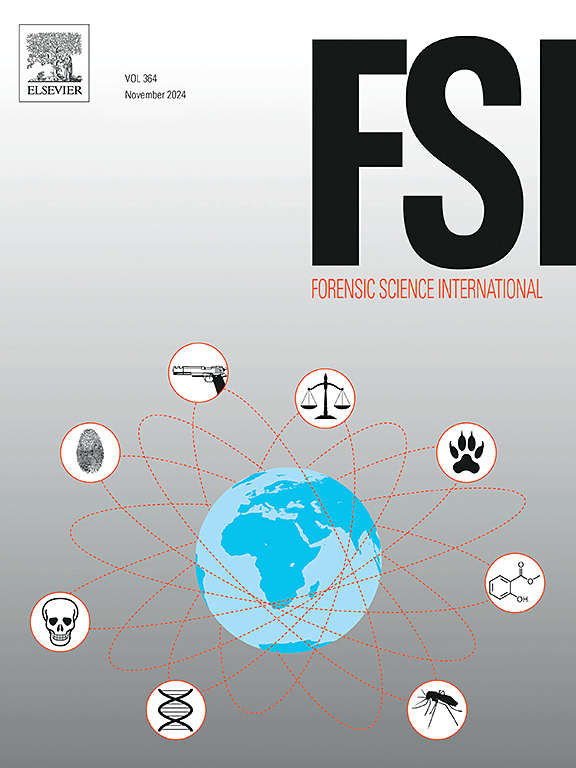Full-length 16S rRNA-based exploration of body site-specific bacterial signatures for origin determination and individual identification
IF 2.2
3区 医学
Q1 MEDICINE, LEGAL
引用次数: 0
Abstract
When the available human-derived information at a crime scene is limited, it poses challenges in determining the origin of the biological materials and identifying their donors. In this context, microorganisms have gradually emerged as a valuable complementary tool. Nowadays, the application of third-generation sequencing technology for full-length 16S rRNA sequencing to explore the specific bacterial biomarkers in various biological materials holds significant research and practical value. In this study, we performed full-length 16S rRNA gene sequencing on sterile swabs from palmar skin, oral mucosa, and nasal cavity using the PacBio single-molecule real-time sequencing (SMRT) platform. Alongside identifying specific bacterial biomarkers for these biological materials from different body sites, the study also preliminarily explored the specific bacterial taxa in 19 individuals at the phylum, genus, and species levels. The results showed that the palmar skin bacteria primarily consist of Cutibacterium, Staphylococcus, and Streptococcus, the oral mucosal bacteria are dominated by Streptococcus, Neisseria, and Haemophilus, while the dominant bacteria in nasal cavity are Staphylococcus and Cutibacterium. Beta diversity analysis revealed significant differences in the bacterial community composition across the three origins of biological materials. Furthermore, classification models based on the bacterial species were constructed using the Random Forest, XGBoost, and KNN algorithms. The results showed that both Random Forest and XGBoost models achieved an accuracy of 97 %, significantly outperforming the KNN model (79 %). The prediction accuracy at the OTU level was comparable to that at the species level. In addition, bacterial community differences between individuals were observed at both the genus and species levels. Overall, this study further explores the potential of classification prediction methods based on bacterial features for distinguishing the body site origins of different biological materials and enabling individual traceability, thereby providing valuable data to support the application of microbiological techniques in forensic practice.
基于全长16S rrna的身体部位特异性细菌特征的探索,用于起源确定和个体鉴定
当犯罪现场可获得的人类来源信息有限时,它在确定生物材料的来源和确定其捐赠者方面提出了挑战。在这种情况下,微生物逐渐成为一种有价值的补充工具。目前,应用第三代测序技术进行全长16S rRNA测序,探索各种生物材料中特异性细菌生物标志物具有重要的研究和实用价值。在本研究中,我们使用PacBio单分子实时测序(SMRT)平台对来自手掌皮肤、口腔黏膜和鼻腔的无菌拭子进行了16S rRNA全长基因测序。除了从不同的身体部位鉴定出这些生物材料的特异性细菌生物标志物外,本研究还初步探索了19个个体在门、属和种水平上的特异性细菌分类群。结果表明,掌部皮肤细菌主要由表皮细菌、葡萄球菌和链球菌组成,口腔粘膜细菌以链球菌、奈瑟菌和嗜血杆菌为主,鼻腔细菌以葡萄球菌和表皮细菌为主。β多样性分析显示,细菌群落组成在三种生物材料来源之间存在显著差异。此外,利用随机森林、XGBoost和KNN算法构建了基于细菌种类的分类模型。结果表明,随机森林和XGBoost模型的准确率均达到97 %,显著优于KNN模型(79 %)。OTU水平的预测精度与物种水平的预测精度相当。此外,在属和种水平上观察到个体之间的细菌群落差异。总体而言,本研究进一步探索了基于细菌特征的分类预测方法在区分不同生物材料的身体部位来源和实现个体可追溯性方面的潜力,从而为支持微生物学技术在法医实践中的应用提供了有价值的数据。
本文章由计算机程序翻译,如有差异,请以英文原文为准。
求助全文
约1分钟内获得全文
求助全文
来源期刊

Forensic science international
医学-医学:法
CiteScore
5.00
自引率
9.10%
发文量
285
审稿时长
49 days
期刊介绍:
Forensic Science International is the flagship journal in the prestigious Forensic Science International family, publishing the most innovative, cutting-edge, and influential contributions across the forensic sciences. Fields include: forensic pathology and histochemistry, chemistry, biochemistry and toxicology, biology, serology, odontology, psychiatry, anthropology, digital forensics, the physical sciences, firearms, and document examination, as well as investigations of value to public health in its broadest sense, and the important marginal area where science and medicine interact with the law.
The journal publishes:
Case Reports
Commentaries
Letters to the Editor
Original Research Papers (Regular Papers)
Rapid Communications
Review Articles
Technical Notes.
 求助内容:
求助内容: 应助结果提醒方式:
应助结果提醒方式:


